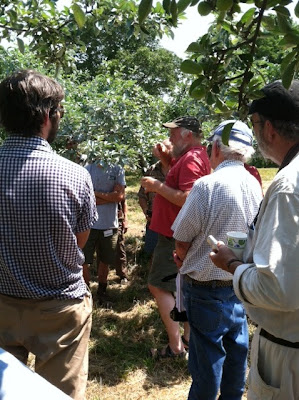Last Tuesday, a diverse group of farmers, land care
professionals, homeowners and students came together to learn about Orchard
Health from Michael Phillips. Michael’s
overall strategy in a nutshell:
Respect for
Biodiversity
Use of Integrated
Components
Use of Biennial
Variations
This sounds like a healthy, organic framework which can be
applied to all of our landscapes, whether for agricultural or ornamental uses.
We began with a discussion about soil health. I noted
Michael’s point that by having lawn under the trees, it deprives the fruit tree
of essential humus layer nutrients as its roots must grow deeper in competition
with the grasses’ roots. It is preferred
to have wood chips under the trees to create a more fungal-dominated soil.
Michael also suggests companion plantings below the trees to encourage
pollinators and to add nutrients to the soil.
I am still intrigued with the idea of having comphrey plants under your
apple trees so their leaves may decay and add calcium to the soil, while
rhubarb should be left to flower and attract pollinators, as its roots break up
compaction in the soil, also. When
viewing a photo of Michael’s orchard in northern New Hampshire, you can’t help
but notice the lack of uniformly mowed rows and the diversity of plant species. In fact, when we visited Allyn’s Orchard
later in the day, Michael suggested mowing only every other row, thus creating
opportunities for wildflowers to bloom to attract pollinators.
Pests will always be a problem, so orcharding is not for the
faint at heart. European Sawfly, Plum Curculio and Codling Moth are the most
serious pests to address. Luckily, Kaolin Clay applications and Spinosad are
two key tools in your organic tool box.
Michael discussed timing of various applications and shared his schedule
with the group. His holistic sprays
include liquid fish, neem oil, seaweed, and sometimes herbal teas such as
nettles, horsetail and comphrey teas.
I cannot lie, it was a real scorcher in the orchard that afternoon. We had 20 committed folks out there, huddled under the shade of the apple trees – all white with kaolin clay. First Anita Kopchinski and Bill Sokol introduced themselves as the caretakers of this orchard, located close to their farm, Hidden Brook Gardens. Michael then led the group in identifying scab, apple-cedar rust and fireblight. Paul Wagner from Soil Food Web NY was on site to explain the results of the soil food web test which he conducted for the orchard. He suggested that woodchips be added to the soil surrounding the trees to encourage a shift from bacterial dominated soil to fungal dominated.
 |
| Wassail Ceremony |
The day was ended with a lovely Wassail Ceremony, in which
the group all participated. We toasted
to the apple trees, asking them to provide a bountiful harvest, and asked the
darker forces, such as deer and pests to stay away. Michael brought some hard cider for all to
share, we literally drenched some toast in the cider and hung it on the tree,
and sang an ancient song. Stuart Rabinowitz had the honor of being the deer by
holding antlers above his head and dancing around the circle. It was awesome!
Thanks to Michael Phillips, Bill and Anita, Connecticut
College, Soil Food Web NY and to all who attended.


